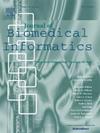ARCH:通过聚合叙事编纂健康记录分析的大规模知识图谱。
IF 4
2区 医学
Q2 COMPUTER SCIENCE, INTERDISCIPLINARY APPLICATIONS
引用次数: 0
摘要
目的:电子健康记录(EHR)系统包含丰富的临床数据存储为编码数据和自由文本叙述笔记(NLP)。电子病历的复杂性在特征表示、信息提取和不确定性量化等方面提出了挑战。为了应对这些挑战,我们提出了一种高效的聚合叙事编纂健康(ARCH)记录分析,为一套全面的电子病历编纂和叙述特征生成大规模知识图(KG)。方法:利用1250万例退伍军人事务患者的数据,ARCH首先导出嵌入向量,生成相似度并结合相关p值,以统计确定性量化衡量临床特征之间的相关性强弱。其次,ARCH执行稀疏嵌入回归,去除特征之间的间接联系,构建稀疏KG。最后,ARCH在各种临床任务中得到验证,包括检测实体对之间的已知关系、预测药物副作用、疾病表型以及阿尔茨海默病患者的亚型。结果:ARCH为超过60,000个编纂和叙述的EHR概念提供高质量的临床嵌入和KG。KG和嵌入在R-shiny驱动的web-API3中可视化。ARCH对EHR概念关系的检测准确率较高,相似EHR概念的auc分别为0.926(编码)和0.861 (NLP),相关概念对的auc分别为0.810(编码)和0.843 (NLP)。检测药物副作用的AUC为0.723,经过微调后提高到0.826。同时使用编码特征和NLP特征,检测能力显著提高。与其他方法相比,ARCH具有更高的准确性,并增强了弱监督表型算法的性能。值得注意的是,它成功地将阿尔茨海默氏症患者分为死亡率不同的两个亚组。结论:本文提出的ARCH算法生成了大规模的高质量语义表示和知识图谱,可用于广泛的预测建模任务。本文章由计算机程序翻译,如有差异,请以英文原文为准。

ARCH: Large-scale knowledge graph via aggregated narrative codified health records analysis
Objective:
Electronic health record (EHR) systems contain a wealth of clinical data stored as both codified data and free-text narrative notes (NLP). The complexity of EHR presents challenges in feature representation, information extraction, and uncertainty quantification. To address these challenges, we proposed an efficient Aggregated naRrative Codified Health (ARCH) records analysis to generate a large-scale knowledge graph (KG) for a comprehensive set of EHR codified and narrative features.
Methods:
Using data from 12.5 million Veterans Affairs patients, ARCH first derives embedding vectors and generates similarities along with associated -values to measure the strength of relatedness between clinical features with statistical certainty quantification. Next, ARCH performs a sparse embedding regression to remove indirect linkage between features to build a sparse KG. Finally, ARCH was validated on various clinical tasks, including detecting known relationships between entity pairs, predicting drug side effects, disease phenotyping, as well as sub-typing Alzheimer’s disease patients.
Results:
ARCH produces high-quality clinical embeddings and KG for over 60,000 codified and narrative EHR concepts. The KG and embeddings are visualized in the R-shiny powered web-API.3 ARCH achieved high accuracy in detecting EHR concept relationships, with AUCs of 0.926 (codified) and 0.861 (NLP) for similar EHR concepts, and 0.810 (codified) and 0.843 (NLP) for related pairs. It detected drug side effects with a 0.723 AUC, which improved to 0.826 after fine-tuning. Using both codified and NLP features, the detection power increased significantly. Compared to other methods, ARCH has superior accuracy and enhances weakly supervised phenotyping algorithms’ performance. Notably, it successfully categorized Alzheimer’s patients into two subgroups with varying mortality rates.
Conclusion:
The proposed ARCH algorithm generates large-scale high-quality semantic representations and knowledge graph for both codified and NLP EHR features, useful for a wide range of predictive modeling tasks.
求助全文
通过发布文献求助,成功后即可免费获取论文全文。
去求助
来源期刊

Journal of Biomedical Informatics
医学-计算机:跨学科应用
CiteScore
8.90
自引率
6.70%
发文量
243
审稿时长
32 days
期刊介绍:
The Journal of Biomedical Informatics reflects a commitment to high-quality original research papers, reviews, and commentaries in the area of biomedical informatics methodology. Although we publish articles motivated by applications in the biomedical sciences (for example, clinical medicine, health care, population health, and translational bioinformatics), the journal emphasizes reports of new methodologies and techniques that have general applicability and that form the basis for the evolving science of biomedical informatics. Articles on medical devices; evaluations of implemented systems (including clinical trials of information technologies); or papers that provide insight into a biological process, a specific disease, or treatment options would generally be more suitable for publication in other venues. Papers on applications of signal processing and image analysis are often more suitable for biomedical engineering journals or other informatics journals, although we do publish papers that emphasize the information management and knowledge representation/modeling issues that arise in the storage and use of biological signals and images. System descriptions are welcome if they illustrate and substantiate the underlying methodology that is the principal focus of the report and an effort is made to address the generalizability and/or range of application of that methodology. Note also that, given the international nature of JBI, papers that deal with specific languages other than English, or with country-specific health systems or approaches, are acceptable for JBI only if they offer generalizable lessons that are relevant to the broad JBI readership, regardless of their country, language, culture, or health system.
 求助内容:
求助内容: 应助结果提醒方式:
应助结果提醒方式:


